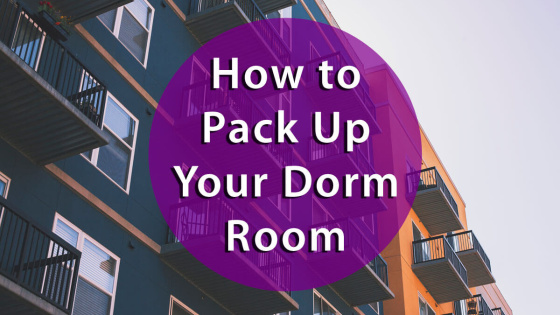Are you looking for a self storage unit with 24 hour access that is also near you? There is a convenient option that you might not have considered and it’s closer to your home than any storage facility.
Continue Reading..
Blog
Nov

Apr

The school year is just about over – summer is so close you can almost taste the piña coladas (or virgin piña coladas), but first you have pack up your dorm room. Here are some tips on how to pack and how to pack using a mobile storage container.Continue Reading..
May

Students should focus on Finals not worry about moving out of their dorm or off campus housing.
We provide services to take the stress off of students, since they will already be stressing out about cramming for their finals.
It’s not too late to take advantage of our moving and storage services for students. Call today or get a free quote online.
Continue Reading..
Mar

Spring is just around the corner! You know what that means… it’s time to do some spring cleaning.
Below we have 7 greats tips to help you make your kitchen sparkly clean!
Where to start:
Cleaning the kitchen can be overwhelming and knowing where to start is the first problem.
The stove is usually the dirtiest part of the kitchen, and you don’t want to be spreading that dirt and grease around the rest of your kitchen. Thus, you want the stove to be the very last thing you clean. This means you always start on either side of the stove moving clockwise or counterclockwise so that you end up cleaning the stove last.
Sanitize the Sink:
Fun Fact: Your dirty kitchen sink has more bacteria than your toilet seat.Continue Reading..
Jan
We are happy to announce that we received the Angie’s List Super Service Award for 2012! It is nice to be recognized of our great customer service and we appreciate all the great reviews on Angie’s List from our loyal customers.
Jan
Check out the Move for Hunger website. 123 Moving and Storage is happy to be working with Move for Hunger. It’s a great company and a great cause! Get involved today by donating your extra canned goods and other food in your pantry!
Jan
The history of Habitat
Summary
Habitat for Humanity International was founded in 1976 by Millard and Linda Fuller. Today, Habitat for Humanity is a true world leader in addressing the issues of poverty housing.
Koinonia Farm
The concept that grew into Habitat for Humanity International was born at Koinonia Farm, a small, interracial, Christian community outside of Americus, Georgia. Koinonia Farm was founded in 1942 by farmer and biblical scholar Clarence Jordan.
The Fullers first visited Koinonia in 1965. They had recently left a successful business and an affluent lifestyle in Montgomery, Alabama to begin a new life of Christian service.
At Koinonia, Jordan and Fuller developed the concept of “partnership housing.” The concept centered on those in need of adequate shelter working side by side with volunteers to build simple, decent houses.
The Fund for Humanity
The houses would be built at no profit and interest would not be charged on the loans. Building costs would be financed by a revolving fund called “The Fund for Humanity.”
The fund’s money would come from the new homeowners’ house payments, no-interest loans provided by supporters and money earned by fund-raising activities. The monies in the Fund for Humanity would be used to build more houses.
Inception of Habitat for Humanity
In 1968, Koinonia laid out 42 half-acre house sites with four acres reserved as a community park and recreational area. Capital was donated from around the country to start the work.
Homes were built and sold to families in need at no profit and no interest. The basic model of Habitat for Humanity was begun.
Zaire
In 1973, the Fullers decided to apply the Fund for Humanity concept in developing countries. The Fuller family moved to Mbandaka, Zaire (now the Democratic Republic of Congo.) The Fullers’ goal was to offer affordable yet adequate shelter to 2,000 people. After three years of hard work to launch a successful house building program, the Fullers returned to the United States.
Expansion into Habitat for Humanity International
In September 1976, Millard and Linda called together a group of supporters to discuss the future of their dream. Habitat for Humanity International as an organization was born at this meeting. The eight years that followed, vividly described in Millard Fuller’s book, “Love in the Mortar Joints,” proved that the vision of a housing ministry was workable. Faith, hard work and direction set HFHI on its successful course.
Phenomenal growth
In 1984, former U.S. President Jimmy Carter and his wife Rosalynn took their first Habitat work trip, the Jimmy Carter Work Project, to New York City. Their personal involvement in Habitat’s ministry brought the organization national visibility and sparked interest in Habitat’s work across the nation. HFHI experienced a dramatic increase in the number of new affiliates around the country.
Habitat today
Through the work of Habitat, thousands of low-income families have found new hope in the form of affordable housing. Churches, community groups and others have joined together to successfully tackle a significant social problem―decent housing for all.
Today, Habitat has helped build or repair more than 600,000 houses and served more than 3 million people around the world.
Jan
As we all know, and most of us have experienced at least once, moving, at the best of times, is difficult. So, when you add the extra emotional stress of a major life change, such as a divorce, death or economic crisis, a move can be a breaking point.
The hard part is, many people have to move – as opposed to wanting to – because of the reasons above. Feeling that they don’t have a choice in their decision to move, many feel that their lives are spinning out of control.
If you’re in this situation, and a move is something you must do, then there are some tips to consider to help you through this extremely difficult time. And remember, you’re not just moving into a new home, you’re moving into a new life.
Take What You Need
After the death of my mother, I was at such a loss. With a house full of memories surrounding me, I didn’t know where to turn. All I knew was that I had to make some decisions.
Usually, when someone is moving, I suggest that they get rid of everything they haven’t used in the last year to minimize the amount of stuff they have to move. For people who are going through an emotional trauma as well as a move, I suggest the opposite.
When emotions are involved, our personal things tend to comfort us and make us feel more secure, especially when our lives feel like they are anything but secure. Take what you need to help you get through. If you’re having a hard time making a decision about whether to move something or not, move it and make the decision at a later time when you feel ready.
When it came time to sort through my mother’s clothes, I couldn’t do it. Each time I opened her closet, I cried for hours at a time. Finally, I asked a neighbor for help. She kindly folded my mother’s clothes into large containers that I then labeled and set aside. Those clothes moved with me across the country then down to California. I finally, when I was ready, went through them, piece by piece. I donated most of her clothes to local charities, keeping just a few sweaters that I know I’ll grow into one day.
Even though I was a very poor student at the time, I made the choice to do only what I could emotionally do. And even though it cost me more money to ship the extra containers, I’m glad that I did.
The last word on this is, do what you have to do to get through.
Try Not to Make Rash Decisions
My moving habits are pretty established by now, and it’s taken me a while to be able to step back and not make rash decisions based on how I might feel emotionally. While it’s good to listen to your feelings, throwing out the dishwasher because it was your ex-partner bought it for you for your anniversary, may not make the most economical sense…although, selling it might!
Before you throw out everything attached to a bad memory (the opposite of the first tip), step back and consider if it’s something you really can’t live with. If you can’t – you really can’t – get rid of it.
I only caution making decisions out of spite. Usually, those decisions end up being regretted. If, however, you can’t stand to look at something because it conjures up difficult emotions and you know you’d feel better if that object was out of your life, then by all means, sell it, donate it or junk it.
Ask for Help
Our pride can be such a hindrance sometimes, making us feel like we should be able to handle the situation on our own. As I’ve said before, moving is one of the hardest things you’ll ever do – moving into a new life, is even tougher. So, don’t feel embarrassed to ask for help. People around you often feel so helpless as they watch you struggle through that asking them to do something for you can not only help you, but can make them feel useful, too. Everyone wins!
So, if you need some tasks done, or you need help packing or sorting things (like the neighbor who kindly sorted my mother’s clothes) or you need a babysitter, ask your friends, family and neighbors.
If you’re having a hard time making a decision about the move or about the choices you’re about to make, talk it out with a friend or counselor – someone who has your best interest at heart. Professional help is always such a support during times like this; they can help clarify your situation and assist you in making some difficult decisions.
Be Good to Yourself
Starting a new life is emotionally and physically draining. Be good to yourself during this time. If you’re tired, sleep; if you’re wanting time alone, give it to yourself. Go get your hair styled or get a massage or take some time to watch a movie or two, even if you feel like there’s so much to do. By giving yourself what you need, you’re allowing yourself to heal.
Remember, you’re going to feel tired, exhausted and drained. That’s part of the process, so stop being hard on yourself, ask for help, and talk it out to someone. And above all, take a deep breath, hug your kids and know that your life will get better – it just takes time.
Jan
Happy New Year from the We Come 2 U Storage Family. We hope you had a great 2012 and an even better 2013. Thank you to everyone who used our services, recommended our services, and even just took a look at our blog.
Jan
Happy Holidays! Hope you are all moved into your new homes ready to share it with family and friends. If you need any assistance in getting that home in tip top shape give us a call and we would be more than happy to assist you or refer you to one of our preferred organizers.



